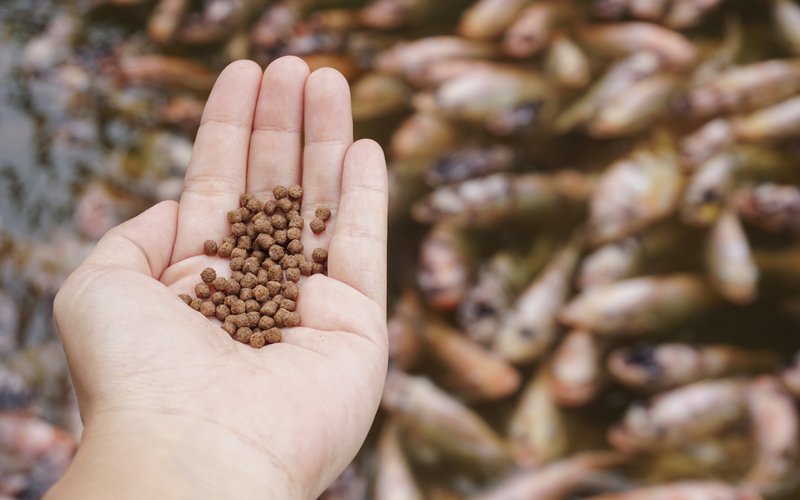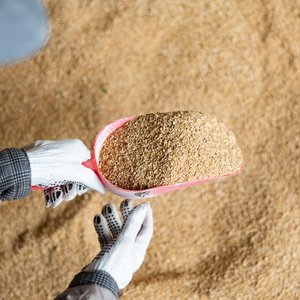In the first article in this series, we presented some of the alternatives that feed mills have to totally or partially replace fishmeal and fish oil in times of high prices or shortages.
“Thirty years ago, marine ingredients accounted for 70% of aquafeeds,” said Emmanuel Pruvost, global EMEA sales manager at Kemin AquaScience™. The current global average is less than 10% inclusion of marine ingredients – 4.9 million tonnes of marine ingredients in more than 60 million tonnes of feed, according to IFFO – The Marine Ingredients Organization. “It means the aquafeed industry was and is able to adapt itself to this type of situation,” Pruvost said.
“This reduction has been achieved by technological improvements (e.g. better processing of certain vegetable meals) but also by optimizing the use of different traditional land-based feed ingredients by combining them so that a single ingredient does not surpass a certain (potentially adverse) threshold. In other words, having a diverse basket of ingredients has been key to substantially reducing fishmeal and fish oil levels in aquafeeds,” Sofia Morais, innovation aqua team leader at Lucta, said.
“The aquafeed industry has made notable progress in diversifying its raw material sources with alternative ingredients. However, the adequacy of these alternatives during fishmeal and fish oil shortages depends on species-specific requirements, the scalability of production, nutritional quality and environmental sustainability. While alternative sources offer viable solutions in many cases, ongoing research, development and collaboration within the industry are crucial to ensure a broader range of options and adaptability to varying aquaculture needs,” said Frederic Baron, aquaculture nutritionist creation design & development at ADM.
Formulation challenges
The diversification of the raw material sources is good news but it is also a challenge for feed formulators.
“There are numerous alternatives to replace marine ingredients. The trick is knowing how to formulate diets with these ingredients to achieve the nutritional composition and physical characteristics needed in aquafeed, such as whether the feed sinks, floats, or suspends in water,” Tom D’Alfonso, director of Animal & Aquaculture, USSEC. “The IAFFD is a commercial standard aquaculture feed formulation database for over 30 commercially important species that provides detailed information for over 700 feed ingredients to help feed formulators.”
“A good strategy for nutritionists aiming to maintain the performance and improve the sustainability of aquafeeds is to replace fishmeal and fish oil with locally sourced alternative ingredients combined with the adequate balance of functional enhancers. The ingredient crisis induced by the pandemic and the Ukraine war has shown that we should be prepared for very different raw material scenarios. In aquaculture, this requires hard work in building know-how in alternative ingredients and functional nutrition,” said Martin Guerin, regional technical manager aquaculture at Adisseo.
“In the case of a fish-free diet, you have to consider various factors, such as palatability, protein quality and digestibility, amino acid profile, mineral composition, and fatty acid composition. As every species has different needs for all these parameters, adaptation has to be made differently for all species. Furthermore, each country has different regulations and raw materials available,” said Pierre Fortin, aquaculture manager, Techna.
“The success of the transition to alternative ingredients depends on the ability of feed formulators to develop balanced diets that meet the needs of the animals, taking into account palatability and economic feasibility. The diversity of options available provides a solid foundation for mitigating the challenges associated with fishmeal and fish oil shortages while promoting the sustainability of the aquafeed industry,” said Robson Sfaciotti Barducci, Biorigin R&D.
“In the context of high fishmeal price and low selling prices (European seabream and shrimp), it is often (but not always) better and more economical for the whole industry to produce a cheaper feed, even with slightly lower performances and production rather than trying to safeguard the exact same formula you had for many years at all cost. Helping decision-makers do the right thing and target the best formula within the existing context is key,” said Fortin. “One key advice we always give our customers is to work with various suppliers even for the same product quality. In situations of shortage, it might save you, and it also allows you to compare prices.”
“As aquafeed formulations continue to change and move beyond the use of fishmeal and fish oil as formulation pillars, new optimization will be required. It will still take time to fully develop the new generation of highly-performing aquafeeds using ingredients that, in many cases, are less ‘natural’ for the aquatic animal,” Morais stated.
Moving away from marine-based ingredients
Despite the current context, marine ingredients are and will be in the basket of aquafeed mills. “Aquaculture is making strategic use of marine ingredients and increasingly using fish byproducts as raw materials. Already one-third of marine ingredients are produced from fish byproducts. Byproduct utilization from both direct-human-consumption fisheries and notably aquaculture production is expected to keep increasing,” said IFFO’s director general, Petter Martin Johannessen.
Still, other raw materials are needed out of marine-based ingredients. “There is not a perfect emerging ingredient today that can provide protein or oil that is nutritionally sound, produced at scale, with regulatory approval, and economically viable. Ideally, nutritionists would prefer to have 3+ equivalent ingredients to remain flexible and address the various needs of the industry,” said Guillaume Salze, senior aquaculture nutritionist at KnipBio.
“Fishmeal and fish oil are not only excellent sources of protein and n-3-HUFAs, respectively, but also provide other important critical nutrients and functional compounds that influence feed intake and digestibility,” said Waldo Nuez-Ortín, global R&D manager aquaculture at Adisseo.
In providing these important compounds when replacing marine ingredients, feed additives are key. “A lot can be gained by complementing the new basket of ingredients with additives that either deliver compounds that are naturally present in marine ingredients, especially fishmeal, and lacking in novel ingredients, or that modulate metabolic and physiologic pathways in similar ways,” Morais said.
Not only are they key in formulation, but they also have an impact on costs. “Feed additives are added at quite low levels and allow feed producers to replace expensive, scarce fishmeal and fish oil with cheaper alternatives and have the same or even higher productivity,” Matthijs de Jong, Central Technical Manager at Orffa Additives, said.
“Feedmills can tailor the application of the additive portfolio depending on the local availability and cost of raw materials to improve the sustainability and cost-effectiveness of the diets with reduced fishmeal and fish oil content,” Marleen Dehasque, global product manager Aqua Nutrition, Adisseo, said.
The type and magnitude of the effects of feed additives largely depend on the alternative ingredients used to replace fishmeal and fish oil. “Like most feed additives, these products are not ‘magic bullets’ as they do not work in isolation. They can be better described as modulators or sometimes ‘boosters’ of a certain effect or pathways, so we need to look at alternative aquafeed formulations holistically and understand how we can best optimize them by looking for synergisms, or at least beneficial interactions, among the different ingredients and additives available in the formulator’s basket,” Morais said.
“Overall, the cost-effectiveness of ingredients in aquaculture feeds relies on a blend of considerations, encompassing nutritional content, market pricing, sustainability factors, and the specific dietary requisites of target fish species. Producers and researchers strive to strike a harmonious balance between cost, nutritional value, and sustainability when designing aquaculture diets, with the ultimate aim of optimizing outcomes for both the industry and the environment,” said Leticia Graziele Pacheco, Biorigin R&D.
“I sincerely feel like, it’s by discussing and testing together that the industry will find the best solution(s) to each situation it will face. We always encouraged more open communication between farmers, and feed millers and more exchanges on the formula information and feedback from farm results with mutual respect for each other's work,” said Fortin.
Credits: rawpixel.com, Freepik
How about sustainability?
“Using less fishmeal could initially sound more sustainable, but in some cases, when taking into account all aspects such CO2, other GHG, water consumption, etc., lowering fishmeal might not be the most sustainable option, also considering that not every fishmeal is the same depending of its origin (geographical, fishing technique, whole fish or trimmings, etc.),” said Fortin.
Today, responsible sourcing and production practices are increasingly seen by the marine ingredients sector as a non-negotiable condition as they underpin its long-term future. “Nearly half of all marine ingredients produced globally are certified under the MarinTrust standard as being sourced and produced responsibly. In addition to independent certification standards, like those of MarinTrust, other long-term studies by global teams of scientists have shown that small pelagics are among the most sustainable of all global fisheries,” said Johannensen.
“It is now fairly well established that fishmeal and fish oil used by the industry nowadays can be considered ‘sustainable’, or is at least in an exceptional direction towards achieving this,” Morais said. She states that the current context might be a risk of seeing a backward step in the industry’s sustainability path.
“The trend seemed to start moving away from the marine ingredients focus, knowing that these are strategic ingredients that need to be used sparingly in formulas, to ‘what else’ is used to fill the ingredients/nutrients gap and what sustainability metrics do they bring into the formulas, or how they may affect feeding and production efficiency. Therefore, there could be a non-negligible risk that the present situation could lead to some regression in this trend. The companies already firmly rooted in this path and which have the financial strength to prioritize footprint above profit should not deviate from their sustainability targets. Nevertheless, most of the industry will be in ‘survival mode’ and hence might need to halt their sustainability targets in the short term,” Morais said.
Sustainability can be defined in a variety of ways. “If improved sustainability is the reduction of fishmeal and fish oil in diets, then novel ingredients can offer improvements in sustainability,” said Louis Rens, SVP global ingredients sales, Green Plains. “There are other metrics like greenhouse gas emissions scores that can be modeled and evaluated. The challenge is comparing ingredients to each other correctly and fairly. As long as we can standardize measurement methodologies, we can offer aquafeed companies a way to understand the environmental impact of their sourcing decisions.”
When talking about sustainability, Brett Glencross, technical director at IFFO, highlights that all ingredients bring risks and opportunities. For example, “the carbon footprint (including land use change) of utilizing many of the plant protein alternatives shows some challenges. For example, soybean meal and soy protein concentrate have a carbon footprint that is more than twice and three times that of fishmeal respectively, according to the GFLI database (2023),” Glencross said.
“Novel ingredient production is also exposed to climate change impacts, both in terms of their carbon footprint, of which most novels are substantially higher than marine ingredients, and also that many alternatives depend on agriculture which is just as impacted as fisheries by climate change,” Glencross said. “We only gain adaptability by better understanding all those inherent risks, so we can take advantage of the opportunities.”
“The current situation offers a unique opportunity for the aquaculture industry to reassess its operations and work toward more sustainable practices. This will not only help preserve natural resources but also strengthen the future growth of aquaculture, ensuring that it continues to be an important source of healthy and accessible food for the growing global population,” Robson Sfaciotti Barducci from Biorigin R&D, concluded.
Don't miss the first article in the series:
Fishmeal and fish oil shortage I: What are the alternatives?










